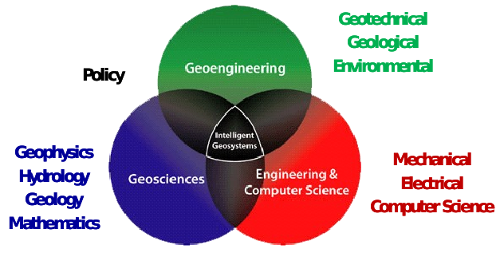Cyber-Enabled Efficient Energy Management of Structures (CEEMS)

Principal Investigator: Tyrone Vincent
Co-Principal Investigators: Kevin Moore, Dinesh Mehta,
Marcelo Simoes, Robert Braun
Sponsor: National Science Foundation
The objective of this research is the development of methods for the control of energy flow in buildings,
as enabled by cyber infrastructure. The approach is inherently interdisciplinary, bringing together electrical
and mechanical engineers alongside computer scientists to advance the state of the art in simulation,
design, specification and control of buildings with multiple forms of energy systems, including generation
and storage. A significant novelty of this project lies in a fundamental view of a building as a set of
overlapping, interacting networks. These networks include the thermal network of the physical building,
the energy distribution network, the sensing and control network, as well as the human network, which in
the past have been considered only separately. This work thus seeks to develop methods for simulating,
optimizing, modeling, and control of complex, heterogeneous networks, with specific application to energy
efficient buildings. The advent of maturing distributed and renewable energy sources for on-site cooling,
heating, and power production and the concomitant developments in the areas of cyberphysical and microgrid
systems present an enormous opportunity to substantially increase energy efficiency and reduce energy-related
emissions in the commercial building energy sector. In addition, there is a direct impact of the proposed
work in training students with backgrounds in the unique blend of engineering and computer science that is
needed for the study of cyber-enabled energy efficient management of structures, as well as planned
interactions at the undergraduate and K-12 level.
Enabling Automated Oil and Gas Processes Using Unmanned Mobile Robots
PI: Qi Han
Co-PI: John Steele
Sponsor: Petroleum Institute, UAE
The presence of toxic gasses (such as H2S) and very high outdoor temperatures in the Middle East region poses great risks to staff on the site of oil and gas facilities. In order to improve safety and increase reliability of oil and gas processes such as inspection, operations and maintenance of oil and gas facilities, this project seeks to automate these tasks using unmanned mobile robots. More specifically, this project conducts research in two areas. The first area is to design and develop a mobile platform, and then design techniques for manipulation. The second area is to develop techniques for navigation, communication, and sensing of the robot.
A Heterogeneous Networking Test Bed to Support Middleware Services for Pervasive Sensing
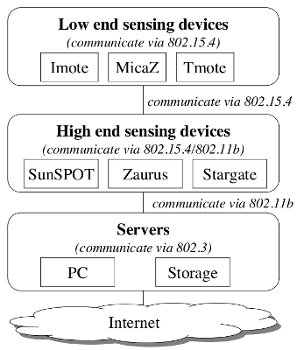
Principle Investigator: Qi Han
Sponsor: National Science Foundation
Numerous interesting applications have been enabled by embedded sensing technologies and significant research progress on wireless sensor networks. To further ensure a wider adoption of this emerging technology, seamless integration of wireless sensor networks with other existing networks such as WiFi and the Internet is a must. In order to address challenges that arise from such an integrated infrastructure, this project builds HeteroNet, a heterogeneous networking infrastructure, by augmenting an existing flat and homogeneous sensor network test bed. HeteroNet integrates resource constrained sensor nodes and more powerful sensing devices, stationary nodes, mobile nodes, and resource sufficient servers. These nodes communicate in wireless or wired fashion. This test bed establishes an experimental infrastructure to serve as a platform for development, testing, validation, and evaluation of the investigator's current research on middleware services for emerging applications on hybrid networks. Research benefiting from HeteroNet includes: integration of interoperable sensor networks to the Internet, amorphous event monitoring in sensor networks, and system status monitoring for QoS-aware mobile applications.
HeteroNet enables research that is not possible via simulation or current small homogeneous sensor network test bed. The findings from the research enabled by HeteroNet have a profound impact on pushing the state-of-the-art of next-generation distributed systems and networks. The development of HeteroNet also benefits educational activities at the graduate and undergraduate levels. HeteroNet is used to facilitate and improve courses on networking, distributed systems, multimedia systems, and computer architectures at the graduate and undergraduate levels.
Intelligent Geosystems
Principal Investigator: Michael Mooney
Co-Principal Investigators: Linda Figueroa, Tracy Camp, Jason Delborne,
Andre Revil
Sponsor: National Science Foundation
This Integrative Graduate Education and Research (IGERT) award supports a Ph.D. training program at the
Colorado School of Mines to pursue integrative research and education in Intelligent Geosystems.
Graduate students will be trained to add real time, adaptive, sensing capabilities to the monitoring
of natural or engineered earth structures, e.g., an earth dam, a ground water system, or a geoconstruction
site (tunneling, urban excavation, highway); the sensor networks employed will allow a geosystem to sense
its environment, diagnose its condition, and make decisions to improve the management, operation, or objective
of the geosystem. The goals are to advance the development of the "intelligent" geosystems while educating
and training a new generation of leaders who are able to operate effectively in this emerging interdisciplinary
area. The proposed IGERT program will institute an interdisciplinary and holistic approach to trainees.
Key components of this IGERT award include: (1) a multi-disciplinary collaborative research team framework
to foster team development and interdisciplinary innovation in intelligent geosystem concepts;
(2) a leadership and teamwork development program to train the next generation of geosystem leaders
for industry, academia and government; (3) a PhD minor in social/environmental ethics & policy to broaden
trainee understanding beyond the technical challenges to the social, environmental and political aspects
of intelligent geosystems; (4) a self-paced cross-disciplinary technical course using modules in intelligent
geosystems; and (5) an internship with a government laboratory or industry in intelligent geosystems.
These five components of this IGERT program will produce diverse, highly skilled leaders with the strong
social and environmental awareness required in multidisciplinary environments. IGERT is an NSF-wide program
intended to meet the challenges of educating U.S. Ph.D. scientists and engineers with the interdisciplinary
background, deep knowledge in a chosen discipline, and the technical, professional, and personal skills
needed for the career demands of the future. The program is intended to catalyze a cultural change in graduate
education by establishing innovative new models for graduate education and training in a fertile environment
for collaborative research that transcends traditional disciplinary boundaries.
For more information, please visit
http://smartgeo.mines.edu/.
Leveraging Low-Dimensional Structure for Time Series Analysis and Prediction
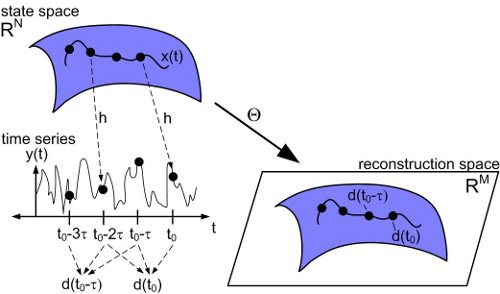
Project Team: Mike Wakin
Sponsor: National Science Foundation
Predicting the behavior of complex systems is central to many tasks of
great scientific and national importance, including arenas such as
meteorology, financial markets and global conflict. Modern science is
ingrained with the premise that repeated observations of a dynamic
phenomenon can help in understanding its driving mechanisms and
predicting its future behavior. The investigators study methods for
improving our ability to characterize and predict such systems even when
they are very large (i.e., with many interacting factors) or appear
highly unordered (i.e., chaotic systems). This research leverages new
mathematical results that enable analysts to efficiently capture the
simple structure that is often present even in systems that appear very
complex. These results lead to improvements and performance guarantees
for heuristic prediction methods based on artificial neural networks,
which are often used in practice but can sometimes fail inexplicably.
Time series prediction is often approached by postulating a structured
model for a hidden system driving data generation. This project borrows
from recent advances in low-dimensional signal modeling to advance the
state of the art in time series analysis and prediction tools when
similar low-dimensional structure is present. For linear systems, this
research develops efficient estimation strategies that improve upon
classical techniques by encouraging sparse solutions. For nonlinear
models, this project builds upon Takens' Embedding Theorem, which states
that the image of an attractor manifold can be reconstructed using a
sequence of time series observations, to guarantee a quantifiably stable
embedding of the attractor manifold. Furthermore, this research aims to
improve upon and make performance guarantees for reservoir computing
methods, where randomly-connected neural networks have been identified
as effective mechanisms for predicting chaotic time series.
Maximizing Wind Farm Energy Production Using Coordinated Turbine Control
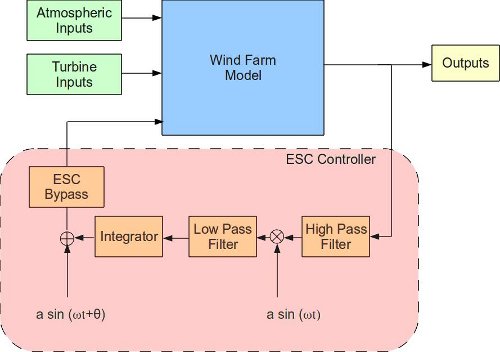
Project Team: Kathryn Johnson
Sponsor: National Science Foundation
Wind farms are becoming more widely used around the country and the globe with the goal of producing cleaner energy more cost effectively. One of the problems encountered in such wind farms is the aerodynamic interaction among turbines that causes a decrease in the total energy extracted from the wind when compared to an equal number of individual turbines operating under the same wind input conditions as the wind farm. The focus of this research is the development of a wind farm simulation model and extremum seeking controller (ESC) that account for and mitigate this aerodynamic interaction among turbines. The simulation model that has been developed that can model the power produced by turbines on a wind farm as wind speed and direction change. The control input to each turbine is the axial induction factor of each turbine, which can be controlled using each turbine’s pitch angle and tip-speed ratio. Unfortunately, the ESC results are not consistent or conclusive. More specifically, we have shown that ESC, using each turbine’s axial induction factors as control variables, can improve the energy capture of our specific wind farm under specific turbine configuration and wind input conditions. However, in other cases total wind farm energy is decreased. The full explanation for increases and decreases is not yet fully understood, and this research has inspired many future avenues for research, including the effect of many different number of turbines and wind farm layouts, the ideal ESC frequency design based on multiple distinct time constants throughout the system, the creation of a set of guidelines for tuning ESC parameters, the optimum ESC bypass structure, and the effect of simulation duration on ESC results.
New Theory and Algorithms for Scalable Data Fusion
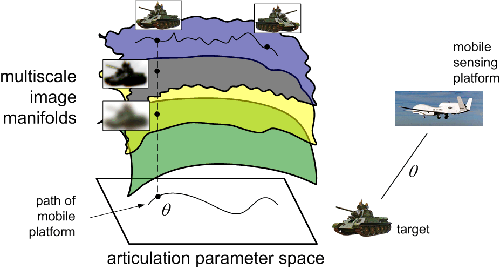
Project Team: Mike Wakin
Sponsor: Air Force Office of Scientific Research
Recent developments in sensor technology, signal processing, and
wireless communications have enabled the conception and deployment of
large-scale networked sensing systems comprising coordinated stationary
and mobile platforms carrying sensors of diverse modalities. The promise
of systems lies in their ability to intelligently make decisions by
integrating information from massive amounts of sensor data. However,
this great promise is offset by a number of critical challenges, which
include growing volumes of sensor data, increasingly diverse data,
diverse and changing operating conditions, novel information appearing,
and increasing mobility of sensor platforms. This project aims to
develop a principled theory of data fusion and decision making that
provides predictable, optimal performance for a range of different
problems through the effective utilization of the available network of resources.
Process Control for Low-Cost Electrochromic Film on Plastic

Principal Investigator: Tyrone Vincent
Sponsor: ITN Energy Systems/Department of Energy
Electrochromic windows have the ability to darken or lighten in response to an electric signal, and if broadly used in buildings they would have the potential to greatly cut back cooling costs by reducing the amount of radiant energy entering the building. Unfortunately, with current manufacturing processes, electrochromic windows remain too expensive for widespread use. With support from the Department of Energy, ITN Energy Systems of Littleton CO is developing a low cost manufacturing process based on a wide-web, continuous processing sputtering systems. CSM is working with ITN Energy Systems on the control systems for this process, as repeatable processes with good cross-web uniformity are key to high yields, and thus low cost manufacturing.

 A network of nodes acting as a virtual antenna to beamform data back to some destination.
A destination may be a base station or another cluster of nodes.
A network of nodes acting as a virtual antenna to beamform data back to some destination.
A destination may be a base station or another cluster of nodes.




